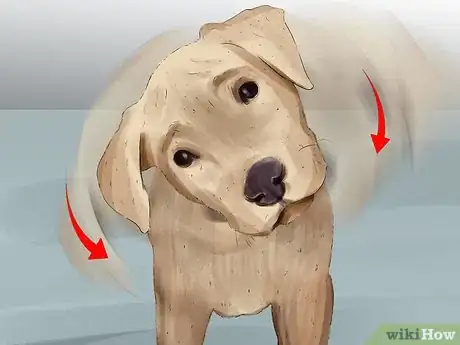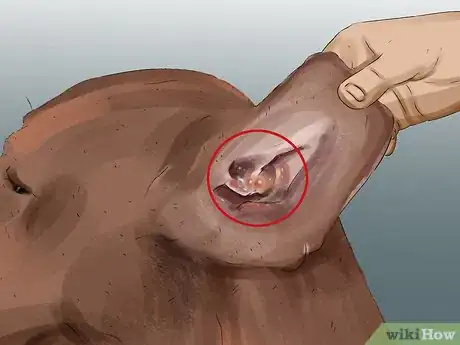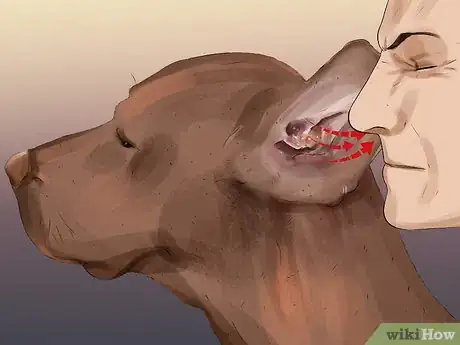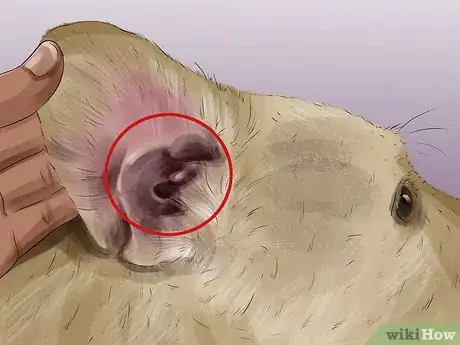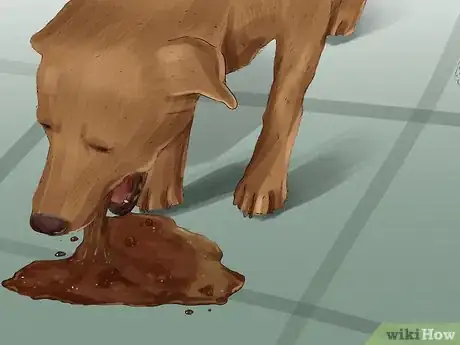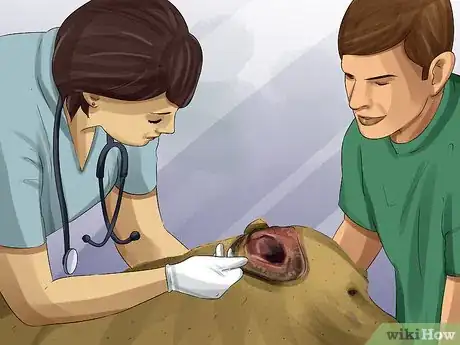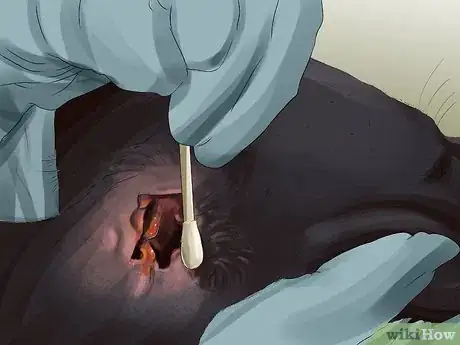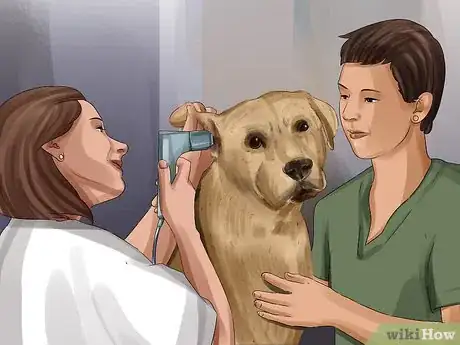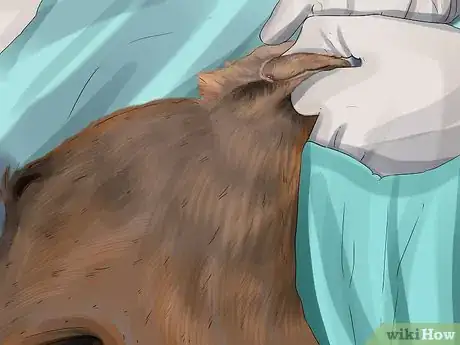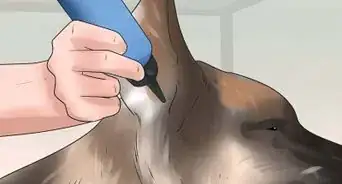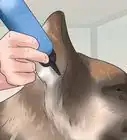This article was co-authored by Melissa Nelson, DVM, PhD and by wikiHow staff writer, Danielle Blinka, MA, MPA. Dr. Nelson is a Veterinarian who specializes in Companion and Large Animal Medicine in Minnesota, where she has over 18 years of experience as a veterinarian in a rural clinic. She received her Doctor of Veterinary Medicine from the University of Minnesota in 1998.
There are 8 references cited in this article, which can be found at the bottom of the page.
This article has been viewed 44,469 times.
Canine ear infections are a common ailment for dogs. Usually, infections are caused by bacteria or yeast. Although some canine ear infections will resolve on their own, it’s best to get treatment from a vet, as ear infections can cause hearing loss or become chronic infections. You can diagnose a canine ear infection by recognizing the symptoms and taking your dog to the vet. Then you’ll be able to treat the infection.
Steps
Recognizing the Symptoms
-
1Notice if your dog is scratching its ear. Your dog may be experiencing some discomfort. If you see it scratching or rubbing its ear more than usual, that could be a sign of an ear infection. The dog may also whine.
- Alternatively, your dog may rub its ear against objects, such as furniture or toys.[1]
-
2Watch for head shaking or tilting. Your dog could be doing this because it's feeling discomfort. It could be a back-and-forth motion, or you may just see the dog holding its head to one side.[2]
- This can also be a symptom of ear mites. Either way, it's best to take the dog to the vet.[3]
Advertisement -
3Examine the ear to check for brown, yellow, or bloody discharge. You may notice either wet or dry discharge. At first, the discharge may just appear deep inside the ear, but it could also be dripping out.[4]
- If you don't see discharge, that doesn't mean that the dog doesn't have an infection. If the dog has other symptoms, it's best to take the dog to the vet.
-
4Smell the ear to see if it has an odor. Healthy dogs don't have smelly ears, so an unpleasant odor in your dog's ear means something is wrong. A pungent, unpleasant odor ear odor may mean it's infected.[5]
-
5Look for swelling, redness, or scabs. Compare the dog’s affected ear to the other ear to check for swelling and redness. It’s normal for the ear to be pink, but a deep red could mean an infection. You may also notice scabbing, especially if the dog has been scratching its ear.[6]
-
6Watch for loss of coordination or walking in circles. The dog may lose its balance and become uncoordinated if the infection is affecting its middle ear. You may notice the dog leaning, staggering, or walking in circles.[7]
- If you notice a loss of coordination in your dog, take it to the vet immediately as this is a sign of a serious infection.
-
7Watch for vomiting. A severe infection can also cause vomiting, especially after the dog has lost its balance. If your dog is showing signs of infection, you should take the dog to the vet immediately.[8]
Getting a Diagnosis
-
1Take your dog to the vet. Since there are many potential causes for the ear infection, it’s important that the vet examine your dog. Your dog may need an antibiotic to treat the infection, which the vet can prescribe. Soon, your dog will be feeling much better![9]
- Make a list of your dog's symptoms to bring with you. You should also note when they started and if they've worsened over time.
-
2Allow the vet to examine your dog’s ear canal and ear drum. They may need to sedate your dog in order to examine the ear and ear drum. This is because the dog may be in pain and could resist the exam. While it sounds scary to have your dog sedated, it's a common procedure that makes the exam easier for the dog.[10]
-
3Expect your vet to take a sample of the discharge using a swab. The vet will insert the swab into the dog’s ear canal to take a sample. The vet can test this sample to determine what is causing the infection.[11]
- If there is discharge, the vet may examine it in the clinic and do a culture to determine what kind of antibiotics are needed for the infection. They may also send it off to a lab in order to determine the best treatment, which could take a few days to a week to complete.[12]
-
4Agree to other diagnostic tests if necessary. In many cases, the vet can make a diagnosis after examining the dog and taking a sample. However, sometimes the vet wants to do more tests so that they can help your dog feel better. They may decide to do a blood test, urinalysis, MRI, or CT scan. A blood test and urinalysis can help the vet determine what is causing the infection, such as a particular bacteria. The MRI and CT scan will allow the vet to see the possible infection.[13]
- They can also check if something is caught in the dog’s ear, which could be causing pain and discomfort. For example, a twig may have gotten caught in the dog's ear.
- MRI and CT scans are specialized tests that are typically performed at universities.
Treating a Canine Ear Infection
-
1Allow the vet to clean out your dog’s ear. The vet will do a deeper than usual cleaning of the dog’s ear. They will remove any debris and buildup that are complicating the infection or causing the dog discomfort. They will also flush the ear with an antiseptic solution.[14]
- If the dog is not already sedated, the vet may choose to give it a sedative before cleaning the ear. This makes the treatment more pleasant for the dog.
-
2Give your dog its medication if the vet prescribes one. Most canine ear infections are easily treated using medications like antibiotics. The vet may prescribe either topical or oral treatments. As long as you follow your vet’s instructions and administer all of the medication, your dog should recover. If they don’t then you should take them back to the vet.[15]
- You may be able to give your dog its medication in food so that it’s less resistant to it.
- Your vet may prescribe your dog antifungal topical medications and ear washes if your dog has a yeast infection.
- If your dog has allergies that are causing its ear infection, your vet may prescribe steroids.
- If your dog is in pain, your vet may prescribe anti-inflammatory pain medications.
-
3Expect the vet to keep the dog overnight for severe infections. This usually only happens if the infection has gotten very serious. The vet will need to give the dog antibiotics and monitor its condition. Although you might worry about leaving your dog at the vet, it can help the dog recover faster. You can be sure that your dog is getting the care it needs to feel better!
- In some cases, the dog may need to stay in the vet’s office for a few days. This will only happen if your dog is very ill.
- An ear infection that has lasted for a long time could cause neurologic issues in the dog. The vet may test for neurologic issues while the dog is staying in their office.[16]
-
4Take your dog to the vet for a check up. After your dog is diagnosed and prescribed treatment, you’ll need to take it back to the vet for a check up. The vet will make sure that your dog has fully recovered.[17]
- Your vet may need to do more diagnostic tests if they believe the dog still has an infection.
-
5Allow the vet to surgically drain the dog’s ears for chronic infections. Very rarely, the vet may need to do minor surgery on your dog. It sounds scary, but it's a relatively simple procedure. Your dog will not experience any pain or discomfort. This may happen if your dog has frequent, recurring ear infections. Your vet will discuss this option with you if they recommend it.[18]
- In rare and serious cases, vets perform a surgery called total ear canal ablation (TECA) to remove the infected tissue in the ear.[19]
References
- ↑ https://www.merckvetmanual.com/dog-owners/ear-disorders-of-dogs/otitis-media-and-interna-in-dogs
- ↑ https://www.merckvetmanual.com/dog-owners/ear-disorders-of-dogs/otitis-media-and-interna-in-dogs
- ↑ https://vcahospitals.com/know-your-pet/ear-infections-in-dogs-otitis-externa
- ↑ https://pets.webmd.com/dogs/dog-ear-infections#1
- ↑ https://vcahospitals.com/know-your-pet/ear-infections-in-dogs-otitis-externa
- ↑ https://pets.webmd.com/dogs/dog-ear-infections#1
- ↑ https://www.petmd.com/dog/conditions/ears/c_multi_otitis_media_interna
- ↑ https://www.petmd.com/dog/conditions/ears/c_multi_otitis_media_interna
- ↑ https://pets.webmd.com/dogs/dog-ear-infections#1
- ↑ https://pets.webmd.com/dogs/dog-ear-infections#1
- ↑ https://www.petmd.com/dog/conditions/ears/c_multi_otitis_media_interna
- ↑ https://www.merckvetmanual.com/eye-and-ear/otitis-externa/overview-of-otitis-externa
- ↑ https://www.merckvetmanual.com/dog-owners/ear-disorders-of-dogs/otitis-media-and-interna-in-dogs
- ↑ https://www.merckvetmanual.com/dog-owners/ear-disorders-of-dogs/otitis-media-and-interna-in-dogs
- ↑ https://www.petmd.com/dog/conditions/ears/c_multi_otitis_media_interna?page=2
- ↑ https://www.petmd.com/dog/conditions/ears/c_multi_otitis_media_interna?page=2
- ↑ https://www.petmd.com/dog/conditions/ears/c_multi_otitis_media_interna?page=2
- ↑ https://www.petmd.com/dog/conditions/ears/c_multi_otitis_media_interna?page=2
- ↑ https://www.willows.uk.net/specialist-services/pet-health-information/soft-tissue/teca
- ↑ https://www.petmd.com/dog/conditions/ears/c_multi_otitis_media_interna?page=2
- ↑ https://www.cesarsway.com/dog-care/ear-care/how-to-clean-dogs-ears
About This Article
If you’re trying to diagnose a canine ear infection, watch to see whether your dog is scratching its ear more than usual, which could be a sign of an infection. Your dog may also shake or tilt its head or rub its ear against furniture, toys, or the floor. Lift the flap of your dog’s ear and check for swelling, an unpleasant odor, redness, scabs, or discharge inside of the ear. All of these could mean that your dog has an ear infection. If you notice any of these signs, take your dog to the vet right away to get antibiotics. For more tips from our Veterinary reviewer, including how to treat the ear infection with your vet's help, read on!

